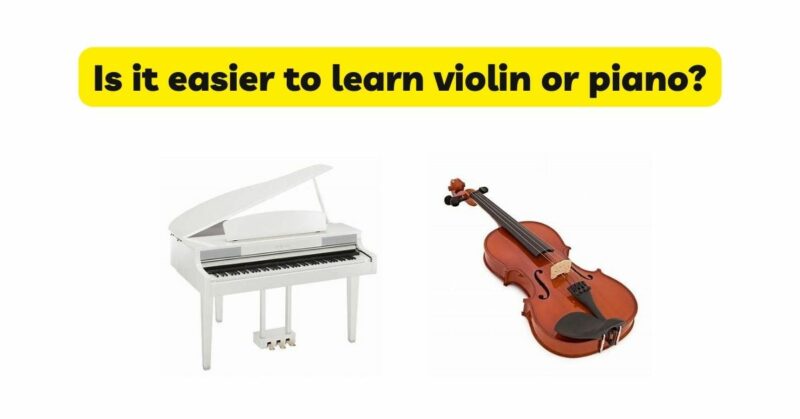The choice between learning the violin or the piano is a decision that many aspiring musicians face. The question of which instrument is easier to learn is a common concern for beginners. While each instrument has its unique challenges, it is important to approach this topic with a balanced perspective. In this article, we will explore various aspects such as technical complexity, physical demands, musicality, and individual learning preferences to shed light on whether the violin or the piano is easier to learn. By considering these factors, we can gain a deeper understanding of the learning process and make an informed decision about which instrument suits us best.
- Technical Complexity: When comparing the technical complexity of the violin and the piano, it is important to consider the learning curve for each instrument. The piano offers a clear visual representation of musical notes on the keyboard, making it relatively easier for beginners to grasp the basics of reading music. Additionally, the keys on the piano produce immediate sound, simplifying the process of understanding pitch and tonality. On the other hand, the violin requires the development of precise finger placement, bowing technique, and intonation. Coordinating these elements to produce a clear and resonant sound can be challenging for beginners. The technical complexity of both instruments should be considered, but personal aptitude and dedication play a significant role in determining the ease of learning.
- Physical Demands: The physical demands of an instrument can affect the perceived ease of learning. The piano requires finger strength, dexterity, and coordination to navigate the keyboard. While developing these skills may take time, the piano provides a relatively stable platform for playing. In contrast, the violin demands physical coordination, posture, and muscle control. Holding the violin correctly, maneuvering the bow, and executing precise finger movements can be challenging for beginners. The violin also requires the development of finger flexibility and stamina. While both instruments have physical demands, personal factors such as prior experience, physical fitness, and adaptability may influence the ease of learning.
- Musicality and Expression: Musicality and expression are integral to both the violin and the piano. The piano offers a broad range of expressive possibilities, allowing for complex harmonies, chords, and melodic lines. With its polyphonic capabilities, the piano provides the opportunity to explore various tonal colors and dynamics. The violin, on the other hand, allows for expressive possibilities through bowing techniques, vibrato, and nuanced finger placement. Learning to produce a clear and resonant sound on the violin requires keen attention to intonation, tone production, and shaping phrases. The ease of learning musicality and expression may vary depending on individual aptitude and preferences.
- Individual Learning Preferences: Individual learning preferences play a crucial role in determining the ease of learning an instrument. Some individuals may have a natural affinity for the tactile nature of the piano, finding it easier to connect with the instrument and understand musical concepts. Others may be drawn to the expressive potential of the violin, finding it easier to express their emotions through its melodic capabilities. Personal learning styles, interests, and motivations are subjective and can influence the perceived ease of learning an instrument. Exploring both instruments and considering personal inclinations can guide beginners in choosing the instrument that resonates with them the most.
- Teaching Methods and Resources: The availability of teaching methods and resources can impact the ease of learning an instrument. Both the piano and the violin have abundant instructional materials, online resources, and qualified teachers. However, it is important to consider the quality and accessibility of these resources. The piano benefits from a vast repertoire, well-established teaching methods, and readily available sheet music. On the other hand, the violin may require more specialized guidance to ensure correct technique and posture. Adequate access to quality instruction and resources is essential for facilitating the learning process and can influence the perceived ease of learning.
- Commitment and Practice: Regardless of the instrument chosen, commitment and consistent practice are key to progress and mastery. Both the piano and the violin require dedicated practice to develop skills, technique, and musicality. The ease of learning is closely tied to the amount of time and effort an individual is willing to invest in their practice routine. Consistency, perseverance, and a growth mindset are essential for overcoming challenges and achieving proficiency, regardless of the instrument chosen.
Conclusion: Determining whether the violin or the piano is easier to learn is subjective and depends on individual factors such as personal aptitude, physicality, musical preferences, and learning style. While the piano may offer a more visually intuitive learning experience and the violin presents unique challenges in technique and physical coordination, both instruments require dedication and consistent practice. It is important for beginners to consider their personal inclinations, access to resources, and commitment to learning when making a decision. Ultimately, the ease of learning an instrument is influenced by individual circumstances, and the most important factor is to choose an instrument that inspires and motivates you. By embracing the learning process with patience, guidance, and persistence, beginners can unlock their musical potential and enjoy the journey of mastering either the violin or the piano.


